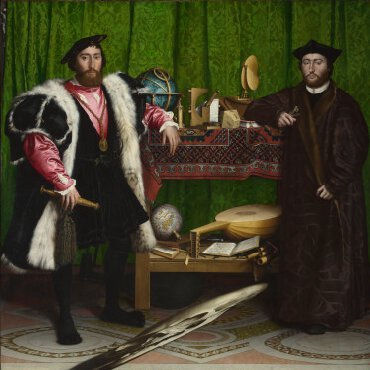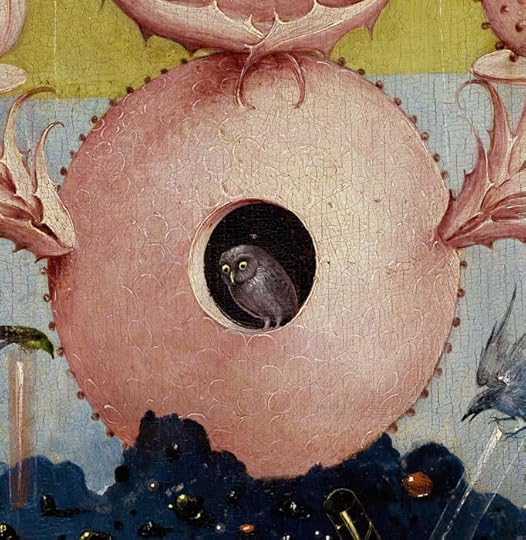Art Lovers discussion
Symbolism in Art
>
What Symbols do you Know?
date newest »
newest »
 newest »
newest »
message 1:
by
Heather
(new)
Nov 16, 2016 04:52AM
 Per my poll, off the top of your head, what symbols can you think of that you have learned have a specific meaning or meanings in different pieces of art?
Per my poll, off the top of your head, what symbols can you think of that you have learned have a specific meaning or meanings in different pieces of art?
reply
|
flag
 slanted skull - memento mori - an object which is supposed to remind the viewer of his mortality ("Remember you must die") . I saw it on old tombstones, in paintings by Renaissance artists, etc.
slanted skull - memento mori - an object which is supposed to remind the viewer of his mortality ("Remember you must die") . I saw it on old tombstones, in paintings by Renaissance artists, etc.
 Ann, you immediately made me think of The Ambassadors by Hans Holbein the younger 1533 because he uses the slanted skull mysteriously in the painting. It doesn't seem to fit, but on closer examination, almost all of the parts of the painting are symbolic.
Ann, you immediately made me think of The Ambassadors by Hans Holbein the younger 1533 because he uses the slanted skull mysteriously in the painting. It doesn't seem to fit, but on closer examination, almost all of the parts of the painting are symbolic. 
"Hans Holbein the Younger’s “The Ambassadors” of 1533 is well known for its anamorphic image of a skull in the foreground (a symbol of mortality), but upon close perusal, the objects on the table between the two subjects prove just as fascinating.
To start with, the painting memorializes Jean de Dinteville, French ambassador to England, and his friend, Georges de Selve, who acted on several occasions as French ambassador to the Republic of Venice, to the Pope in Rome, and to England, Germany, and Spain.
The upper shelf, which is concerned with the the heavens, includes a celestial globe, a portable sundial, and various other instruments used for understanding the heavens and measuring time, while the lower shelf, which reflects the affairs of the world, holds musical instruments, a hymn book, a book of arithmetic, and a terrestrial globe.
Holbein painted “The Ambassadors” during a particularly tense period marked by rivalries between the Kings of England and France, the Roman Emperor, and the Pope. Furthermore, the French church was split over the question of the Reformation. The religious and political strife was reflected symbolically in the details of the painting. Among them:
A crucifix is half-obscured by a green curtain in the top left corner of the painting, symbolizing the division of the church.
The broken string on the lute evokes ecclesiastical disharmony during the Reformation.
The open book of music next to the lute has been identified as a Lutheran hymnal, and the book of mathematics is open on a page of divisions which opens with the word “Dividirt.”
There are also non-political details throughout the work, such as the ages of the sitters being written in Latin on the dagger’s sheath (Dinteville) and on the book on the top shelf (de Selve).
This site also has pictures of the break-down of the entire painting so as to be seen more closely.
https://artstor.wordpress.com/2013/09...
 I was watching a documentary about climate change earlier today and in it a painting came up as a symbolic aspect of the discussion. I immediately thought about this thread. What about considering the multitude of symbols present in Hieronymus Bosch's paintings? Are they symbols or is this a representation of visions and delirium? The beginning of the surreal? Would a Christian of the time walk up to the painting and see symbolic representations of aspects of faith?
I was watching a documentary about climate change earlier today and in it a painting came up as a symbolic aspect of the discussion. I immediately thought about this thread. What about considering the multitude of symbols present in Hieronymus Bosch's paintings? Are they symbols or is this a representation of visions and delirium? The beginning of the surreal? Would a Christian of the time walk up to the painting and see symbolic representations of aspects of faith?Link to larger version for examining details of the painting:
http://cdn1.wallpapersok.com/uploads/...

 Symbolism in Bosch's paintings:
Symbolism in Bosch's paintings:http://www.saylor.org/site/wp-content...
http://www.bennozuiddam.com/SAJAH_29_...
http://hassan331.tripod.com/Bosch/Sym...
 So picking one of these -
So picking one of these - the owl as a representation of the devil and his works.
http://www.esotericbosch.com/owls/bos...



 Very interesting, Haaze. The triptych is supposed to represent the three stages of man's life, correct? Maybe I'm not remembering exactly. And there are symbols in his work of which I am not familiar at all. So these posts were very fascinating.
Very interesting, Haaze. The triptych is supposed to represent the three stages of man's life, correct? Maybe I'm not remembering exactly. And there are symbols in his work of which I am not familiar at all. So these posts were very fascinating. As to your question "Are they symbols or is this a representation of visions and delirium? The beginning of the surreal? Would a Christian of the time walk up to the painting and see symbolic representations of aspects of faith?
Personally, though he uses symbols and has reasons for creating this work, I think the whole thing represents a somewhat demented, almost schizophrenic mind.


